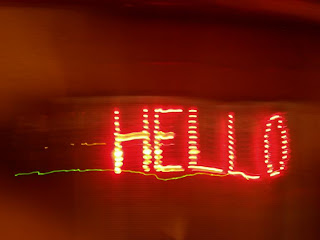My friend told me about the group "Daft Punk" about two months ago--I checked out their music, then saw heard about their helmets. As soon as i saw one, I was immediately attracted to it and it became my goal to make one. Originally, I wanted to have an LED matrix on it that could spell out words, but, in the interest of time (I needed it for a costume party), I had to cut it short to a "knight-rider"-esque display. There's a video below (mind the parents talking...) as well as details as to how it was made. I gave myself a $100 budget for the entire project (would've been a lot cheaper had I already owned an I/O board). I was just overbudget for the whole project by $1.61.
How it was made:

first step. cut out styrofoam blocks. i sketched up a CAD drawing to find proper dimensions then cut them out. I got the foam sheeting at a Home Depot.
This is how they eventually go together.
First Shipment of electronics stuff arrived; LEDs with free resistors for 12V, shame, i could've used 5V... I got these off eBay for $6.99 from china.

This is what the blocks looked like all glued together. I used Gorilla Glue, and it worked nicely.

Second and third shipment of electronics! woo hoo! the second to come in were 4794 LED driver chips and 150 Ohm resistors. A day later came the arduino duemilanove (
http://arduino.cc/en/Main/ArduinoBoardDuemilanove) microcontroller board and the breadboard. I threw together this circuit (
http://www.arduino.cc/en/Tutorial/KnightRider) to make sure it all works. I got the breadboard and the duemilanove from sparkfun (
http://sparkfun.com). I got the 4794 chips (that i ended up not using because of time constraints) and the resistors from mouser electronics (
http://www.mouser.com).

I used a sander and a saw to trim down the block and shape it as such; i know its a bit different than that of the actual daft punk helmets but, oh well.

Again, just a picture of it shaped.

I had yet to cut out the place for the visor at that point.

I put fiberglass sheeting and resin on the foam to give it some strength...

..but the resin ate away at the foam and there were gaps left between foam and fiberglass.

My dad suggested magnet wire for the leads going to the LEDs, we had some lying around, so... (but in reality, these proved frail and difficult to solder.)

Time to heat form acrylic! I read that you could shape acrylic after heating it in an electric oven.

It worked well. We ended up using a toaster oven at 275 degrees.

This is the visor finished after heat forming. I drew it up in CAD beforehand, with the holes plotted out. The label on the acrylic sheet said, "Easy to Cut." Yeah, right. It took a while to figure out how to cut it without it snapping, but eventually i found out that a dremel tool with something that acted as a mill bit would work perfectly. I had printed out the CAD drawing for the holes, and taped that to the piece

Time to sand fiberglass; i had to wear a respirator.

As I said, the fiberglass left gaps, so we filled that with Bondo.

And, with some paint, the visor went in with the electronics and, voila! my own daft punk helmet.


Here's the helmet up close with the electronics box. The paint was only shiny in some places--i think i might have to redo that and put more Bondo on and make it perfect.

Here's the electronics box--I cut out some acrylic, drilled holes, and soldered the wiring to the resistors, and then put the wires in the corresponding pins. Underneath that is the brain of the organization--the Arduino Duemilanove. At the bottom of the tin is the 9V battery that powers it all.

The box was the perfect size for it all--everything fit snugly--but not too snug. This ends up going in one of the pockets of the $3 thrift shop three-piece suit on which i wrote daft punk on the back.









































